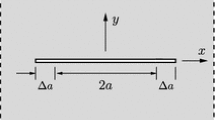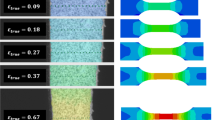Abstract
The paper focusses on the determination of R, the size of the fully developed softening zone associated with a semi-infinite crack in a remotely loaded infinite elastic softening solid. R is a characteristic length for a material, and is important in that if R is less than an appropriate characteristic dimension of a structure, then LEFM principles can be used to describe the structure's failure. With p c and δc being respectively the maximum stress and displacement within the softening zone, then provided the softening is not particularly pronounced, i.e. the area under the stress (p)-displacement (v) curve is % MathType!MTEF!2!1!+-% feaafiart1ev1aaatCvAUfeBSjuyZL2yd9gzLbvyNv2CaerbuLwBLn% hiov2DGi1BTfMBaeXatLxBI9gBaerbd9wDYLwzYbItLDharqqtubsr% 4rNCHbGeaGqiVu0Je9sqqrpepC0xbbL8F4rqqrFfpeea0xe9Lq-Jc9% vqaqpepm0xbba9pwe9Q8fs0-yqaqpepae9pg0FirpepeKkFr0xfr-x% fr-xb9adbaqaaeGaciGaaiaabeqaamaabaabaaGcbaWaaacaaeaacq% GH+aGpaiaawoWaaiaabccacaqGWaGaaeOlaiaabkdacaqG1aGaamiC% aSGaam4yaOGaeqiTdq2ccaWGJbaaaa!3FB5!\[\widetilde > {\text{ 0}}{\text{.25}}pc\delta c\], it is shown that R ∼ 0.4E 0δc/P c and R is relatively insensitive to the precise p-v softening behaviour (E 0 = E/(1 − v 2) where E is Young's modulus and ν is Poisson's ratio. However, when the area under the curve is % MathType!MTEF!2!1!+-% feaafiart1ev1aaatCvAUfeBSjuyZL2yd9gzLbvyNv2CaerbuLwBLn% hiov2DGi1BTfMBaeXatLxBI9gBaerbd9wDYLwzYbItLDharqqtubsr% 4rNCHbGeaGqiVu0Je9sqqrpepC0xbbL8F4rqqrFfpeea0xe9Lq-Jc9% vqaqpepm0xbba9pwe9Q8fs0-yqaqpepae9pg0FirpepeKkFr0xfr-x% fr-xb9adbaqaaeGaciGaaiaabeqaamaabaabaaGcbaWaaacaaeaacq% GH8aapaiaawoWaaiaabccacaqGWaGaaeOlaiaabkdacaqG1aGaamiC% aSGaam4yaOGaeqiTdq2ccaWGJbaaaa!3FB1!\[\widetilde < {\text{ 0}}{\text{.25}}pc\delta c\], then R increases above this 0.4E 0δc/P c value. For this case, and provided most of the area under the p-v curve is not associated with the tail in the softening law, a more appropriate expression for R is R ∼ 0.1E 20 /δ 20 /K 2∞ , with K 2∞ /E 0 being the area under the p-v curve and K ∞ being the stress intensity associated with the full development of a softening zone.
Similar content being viewed by others
References
D.S. Dugdale, Journal of the Mechanics and Physics of Solids 8 (1960) 100.
B.A. Bilby, A.H. Cottrell and K.H. Swinden, Proceedings, Royal Society A272 (1963) 304.
J.R. Rice, in Fracture, H. Liebowitz (ed.), Vol. 2, Academic Press, New York (1968) 191.
J. Planas and M. Elices, International Journal of Fracture 55 (1992) 153.
J.R. Willis, Journal of the Mechanics and Physics of Solids 15 (1967) 151.
E. Smith, Engineering Fracture Mechanics 6 (1974) 213.
E. Smith, International Journal of Engineering Science 27 (1989) 301.
J. Planas and M. Elices, Fracture Mechanics of Concrete Structures, Z.P. Bažant (ed.) Proceedings of First International Conference on Fracture Mechanics of Concrete Structures, Breckenridge, Colorado, USA, Elsevier Applied Science (1992) 939.
Z.P. Bažant and M.T. Kazemi, International Journal of Fracture 51 (1991) 121.
Author information
Authors and Affiliations
Rights and permissions
About this article
Cite this article
Smith, E. ‘When can we apply LEFM principles to elastic softening materials?’. Int J Fract 64, 285–298 (1993). https://doi.org/10.1007/BF00017846
Received:
Accepted:
Issue Date:
DOI: https://doi.org/10.1007/BF00017846




